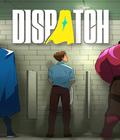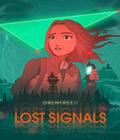At the beginning of 2016, Oxenfree was released among news that it had already been optioned by Skybound Entertainment to bring the game to a movie or TV show. That move hasn't occurred yet, but the game was still a strong adventure title thanks to its supernatural plot and believable characters. After a brief detour that included the release of a second game Afterparty and being purchased by Netflix for its burgeoning games division, Night School Studios has returned with Oxenfree II: Lost Signals, a game that lives up to the bar set by its predecessor.
Oxenfree II is set years after the events of the first title and with a different cast of characters. You play the role of Riley Poverly, a young woman who has returned to her hometown of Camena after bouncing around from city to city while trying to find her life's purpose. On her first day on the job as an environmental researcher, she gets paired up with Jacob Summers to plant radio transmitters to intercept strange signals, and it doesn't take long before things start going awry and the duo need to stop the phenomenon from getting worse.
The story assumes that you know a little bit about the first title, as it starts off with some hallmark elements. Time travel, dimensional warping, and distorted clairvoyance are present in the opening hour, and the game never lets up. Some events that you played through will repeat themselves briefly, and your character is aware that something is amiss. There are moments when you'll see old memories replay, and while you won't see heaps of gore, there will be brief shocking moments such as when you see someone jump off a bridge or drown in a nearby river. It's a treat for those who like their stories to mess with them, and while the game features no way for you to die, it is still enough to make you think that danger is possible.
These dissonant elements make the story more compelling. The game uses these opportunities to build on Riley's backstory to give you a better idea of her character and possibly influence your decisions as the game progresses. This is also used to give you backstory on The Parentage, the group of antagonists whose motivations start to become clear once the dimensional jumps and flashbacks start to occur. They're convenient ways of explaining motivations without having the characters say them outright, but they are quite fascinating since they're still playable sections of the game.
For the most part, Oxenfree II is a modern adventure title that uses a bit of platforming as a means of traversal. The game may be presented in 2D, but the game has movement reminiscent of some 2.5D games in that you can sometimes find a path in the background to walk through. Jumping or climbing requires you to be near an edge or climbable surface, respectively. Hit a button to perform the act, and the same goes for climbing up ropes or attaching them to anchors. The platforming may be simple, especially with the absence of death, but it allows you to concentrate on exploring your surroundings to see if there are alternate paths to a destination or if a note about the lore of the island is lying around. It also gives you an opportunity to fiddle around on the radio to catch stray broadcasts, use your walkie talkie to get random transmissions, or talk to a high school radio host who's dispensing advice.
There are two main elements that Oxenfree II relies on heavily. The first are the puzzles, which can seem tough in unexpected ways. Almost all of the puzzles deal with finding the correct frequency on items, such as finding the right spot to target on a transmitter or dialing into the right frequency on your radio or scanner. Most of the puzzles rely on you hearing if the signal is getting stronger and seeing if it's producing a result, like a beam of light forming a triangle. Others rely on guesswork in hopes that you stumble across the shape they're asking for or observe whether a time rift fluctuates in size. It's more about stumbling across the solution rather than intelligently putting together the pieces in ways that make sense; this is more of a love-it-or-hate-it mechanic, depending on how you feel about puzzles like this.
The second element that drives the game is the dialogue system, and you'll use it the most during the journey. The title is filled with talking, both in and out of cut scenes. Whenever you have the chance to respond, you'll have up to three dialogue choices that are activated with their own button. You also have a fourth option of staying silent by refusing to hit a button, but there are moments when an event will take away that choice. As expected, your choices steer the rest of the conversation, so replayability comes in the form of picking different choices each time and seeing where it goes.
The system is done well, and the quality of the dialogue helps. The dialogue flow feels realistic, as opposed to being fully scripted out, and it never goes on wild tangents. The reactions sound natural, and there aren't any sudden tonal shifts. None of the dialogue breaks the characters traits established through most of the game, and the dialogue flows smoothly when choices are made in the middle of a conversation. Sometimes, your response will come after you let them finish their sentence, while interruptions cause everyone else to circle back on their thoughts after you say your line. Just like the first game, this feels like something you'd expect from a good indie film.
There are only a few complaints about the game. The first is that there's still no clarity on what it means when a character has a picture of another person in their speech bubble. It's never clear if it's negative or positive, so it makes aiming for certain statuses with certain characters very ambiguous. The continuous dialogue feature sometimes doesn't work. The game tells you that moving to a new area during a conversation will enable it to continue, but that isn't always the case. The game seems to count the transitional load times as moments when a conversation is going on, so depending on when you move and how fast your equipment is, you'll either miss part of the conversation or miss the ending. For a game that uses dialogue as a primary mechanic, it's disappointing that this feature doesn't work flawlessly.
Just like the first game, Oxenfree II has an arresting presentation. Graphically, the same charcoal and watercolor techniques make the backgrounds pop in a title that's set predominately at night. It is especially good at making time fissures stand out . The characters are smaller than expected since the camera is pulled so far back, but each one remains distinctive with easily identifiable colors and lanky appearances. Look close enough, and you'll see that the faces remain detailed with mouth movements when speaking and proper eye tracking when they look at other characters. The sound is just as good. The synthwave soundtrack keeps everything creepy, and it does so effectively when you realize that it is silenced during the game's more poignant scenes. The voice acting is also top-notch, with everyone giving terrific performances.
Steam Deck users will be happy with the game's overall performance on the device. With the game set to High, it runs at a constant 60fps at all times with no fluctuations. The game runs at the Deck's native resolution, and the text is perfectly readable. The runtime on a fully charged battery can hit a little below four hours, which is great and gives you wiggle room to make that runtime if you're willing to lock the frame rate or drop the quality settings. The only thing you have to pay attention to is that the game incorrectly sets your resolution the first time out, so if you don't change that right away, the game will run at around less than 360p.
As a sequel, Oxenfree II: Lost Signals is at least on par with the first title. The game strikes a good balance of platforming and puzzle-solving, while also giving you the freedom to figure out things without much hand-holding. The art style may present small characters, but the graphics still shine, and the music is haunting enough to maintain a feeling of unease throughout the adventure. It is once again the fleshed-out characters, deep narrative, and excellent pacing that will keep you hooked on the game from the opening moments all the way to the end credits. For fans of adventure games, Oxenfree II is a worthy buy, even if you've never played the first title.
Score: 8.5/10
More articles about Oxenfree II: Lost Signals











 Oxenfree II: Lost Signals features an all-new cast of characters in a narrative driven, supernatural mystery-thriller set five years after the events of the original.
Oxenfree II: Lost Signals features an all-new cast of characters in a narrative driven, supernatural mystery-thriller set five years after the events of the original.


























